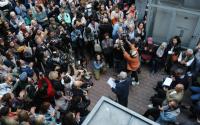15 September 2006Cahal Milmo
Britain has four years to put in place a "road map" to ensure a low-carbon economy where petrol stations would be redundant and wind turbines would be a feature of every home by 2050.
The first comprehensive account of the measures needed to ensure Britain does its bit to avoid dangerous climate change is published today with a warning that failure to act now will only require more drastic action at a later date.
The study by the Tyndall Centre for Climate Change Research, one of the leading scientific bodies on global warming, found that the UK needs to cut its carbon dioxide emissions by 70 per cent over the next 30 years.
The reduction is far greater than that planned by the Government, which has set a target of a 60 per cent reduction by 2050.
Researchers have calculated that in order to do its "fair share" in stopping global temperatures rising by more than 2C - the benchmark for dangerous climate change - Britain can only produce 4.5 gigatonnes (4,500 billion tonnes) of carbon dioxide by 2050.
At current rates of consumption, the UK will emit nearly double this amount by 2050 and is doing too little to reduce reliance on fossil fuels and encourage renewable energy sources, according to the study.
But Friends of the Earth (FoE), which commissioned the report along with the Co-Operative Bank, said it was also clear that a far-reaching programme of action by 2010 - with further targets for 2030 and 2050 - would allow Britain to meets its climate change obligations. Campaigners are calling for this road map to be kick-started by a new government Bill committing Britain to an annual reduction in carbon dioxide of at least three per cent year on year.
Tony Juniper, FoE's executive director, said: "To turn this road map into reality we need a law that commits this and future governments to making annual cuts in the UK's carbon emissions. Without this law politicians will continue to place short-term gains ahead of the long-term decisions needed to get to grips with climate change."
Among the far-reaching measures proposed are the end of the sale of traditional "incandescent" light bulbs by 2010; a move to make most travel to European cities by high-speed double-decker trains by 2030 and a reduction in the use of coal, oil and gas by 70 per cent by 2050.
The document foresees an immediate increase in the use of bio-fuels and renewable energy sources by 2010, accounting for a tenth of electricity production. There will be a massive move towards locally produced electricity with towns and cities having their own large wind turbines and smaller versions on retail parks and open spaces.
By 2030, electric trains will have replaced aircraft for short-haul travel across Europe and airports will cater principally for long-haul flights. Farmers will grow bio-fuels and there will be 10 per cent fewer cars on the roads, most of which will be powered by hydrogen or electricity.
The final target date of 2050, when carbon emissions will have been cut by 90 per cent, will see petrol filling stations replaced by fuelling stops for hydrogen and electricity.
Hydrogen will supply a quarter of all energy needs and small wind turbines and solar panels will be the norm on houses and business premises.
The study, which rules out nuclear power as a source of energy, said that such changes could be brought in without radical changes to current lifestyles and economic growth.
But it warns that more drastic action, likely to affect economic growth, will be required at later dates unless the road map is followed in the next four years.
Dr Kevin Anderson, research director for the Tyndall Centre, said: "Our research demonstrates that the UK can move to a low-carbon economy. However, the journey will become much more demanding the longer the Government leaves it to act."
The future of energy
2010
* All cars must have a minimum fuel consumption of 45mpg and electric cars are common in towns
* Electricity and gas bills state how much carbon has been emitted
* Incandescent light bulbs are no longer on sale, replaced by high-efficiency bulbs
2030
* Double-decker electric trains run on high-speed tracks across Europe with multiple direct routes, eg Manchester to Rome
* City centres are car free and there are 10 per cent fewer cars on the roads following a massive investment in new tram, bus and trolley bus infrastructure
* Renewable energy is a major force with large schemes such as the Swansea tidal lagoon and wind farms operating
* Rush hour is reduced by a large increase in flexible working
* All new housing will have "near-zero" demand for heating and cooling, provided by wind turbines and solar panels
2050
* Hydrogen produces 25 per cent of all energy, including in the home with special fuel cells to provide heat and power
* A third of electricity is produced locally by communal boiler plants that burn gas
* Industrial production is based around hubs which allow "recycling" of energy resources between manufacturing processes
* Petrol stations have been replaced by multi-fuel stations offering hydrogen, electricity and bio-fuels
http://news.independent.co.uk/environment/article1603664.ece






